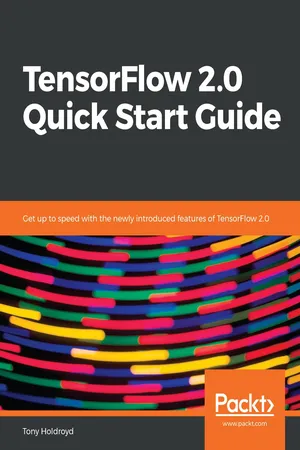
TensorFlow 2.0 Quick Start Guide
Get up to speed with the newly introduced features of TensorFlow 2.0
Tony Holdroyd
- 196 pagine
- English
- ePUB (disponibile sull'app)
- Disponibile su iOS e Android
TensorFlow 2.0 Quick Start Guide
Get up to speed with the newly introduced features of TensorFlow 2.0
Tony Holdroyd
Informazioni sul libro
Perform supervised and unsupervised machine learning and learn advanced techniques such as training neural networks.
Key Features
- Train your own models for effective prediction, using high-level Keras API
- Perform supervised and unsupervised machine learning and learn advanced techniques such as training neural networks
- Get acquainted with some new practices introduced in TensorFlow 2.0 Alpha
Book Description
TensorFlow is one of the most popular machine learning frameworks in Python. With this book, you will improve your knowledge of some of the latest TensorFlow features and will be able to perform supervised and unsupervised machine learning and also train neural networks.
After giving you an overview of what's new in TensorFlow 2.0 Alpha, the book moves on to setting up your machine learning environment using the TensorFlow library. You will perform popular supervised machine learning tasks using techniques such as linear regression, logistic regression, and clustering.
You will get familiar with unsupervised learning for autoencoder applications. The book will also show you how to train effective neural networks using straightforward examples in a variety of different domains.
By the end of the book, you will have been exposed to a large variety of machine learning and neural network TensorFlow techniques.
What you will learn
- Use tf.Keras for fast prototyping, building, and training deep learning neural network models
- Easily convert your TensorFlow 1.12 applications to TensorFlow 2.0-compatible files
- Use TensorFlow to tackle traditional supervised and unsupervised machine learning applications
- Understand image recognition techniques using TensorFlow
- Perform neural style transfer for image hybridization using a neural network
- Code a recurrent neural network in TensorFlow to perform text-style generation
Who this book is for
Data scientists, machine learning developers, and deep learning enthusiasts looking to quickly get started with TensorFlow 2 will find this book useful. Some Python programming experience with version 3.6 or later, along with a familiarity with Jupyter notebooks will be an added advantage. Exposure to machine learning and neural network techniques would also be helpful.
Domande frequenti
Informazioni
Section 1: Introduction to TensorFlow 2.00 Alpha
- Chapter 1, Introducing TensorFlow 2
- Chapter 2, Keras, a High-Level API for TensorFlow 2
- Chapter 3, ANN Technologies Using TensorFlow 2
Introducing TensorFlow 2
image1 = tf.zeros([7, 28, 28, 3]) # example-within-batch by height by width by color
- Looking at the modern TensorFlow ecosystem
- Installing TensorFlow
- Housekeeping and eager operations
- Providing useful TensorFlow operations
Looking at the modern TensorFlow ecosystem
- There's Dataset consisting of fixed length record sets from at least one binary file (FixedLengthRecordDataset)
- There's Dataset consisting of records from at least one TFRecord file (TFRecordDataset)
- There's Dataset consisting of records that are lines from at least one text file (TFRecordDataset)
- There is also a class that represents the state of iterating through Dataset (tf.data.Iterator)
Indice dei contenuti
- Title Page
- Copyright and Credits
- Dedication
- About Packt
- Contributors
- Preface
- Section 1: Introduction to TensorFlow 2.00 Alpha
- Introducing TensorFlow 2
- Keras, a High-Level API for TensorFlow 2
- ANN Technologies Using TensorFlow 2
- Section 2: Supervised and Unsupervised Learning in TensorFlow 2.00 Alpha
- Supervised Machine Learning Using TensorFlow 2
- Unsupervised Learning Using TensorFlow 2
- Section 3: Neural Network Applications of TensorFlow 2.00 Alpha
- Recognizing Images with TensorFlow 2
- Neural Style Transfer Using TensorFlow 2
- Recurrent Neural Networks Using TensorFlow 2
- TensorFlow Estimators and TensorFlow Hub
- Converting from tf1.12 to tf2
- Other Books You May Enjoy